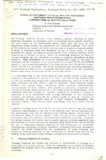| dc.description.abstract | The building materials industry though lacking a' precise" definition in many
-count:ries.,rrepr-esents81L.imrpopta~t .K!'oGlifl,of.i.'ldust-r .ies whose outputs .consti t ute
the main inputs in the construction sector which take the form of civil
engineering works, houses, and commercial and industrial buildings. The nature
of the construction output will determine the type of production inputs required
in terms of materials, plant and equipment as well as labour skills. In many
countries the inputs are obtained predominantly from imported sources, which
requires use of foreign exchange. Since. the developing countries are short of
foreign exchange, we must therefore be careful to minirnise expenditure of hard'
currency .. Hig.h dependence on imported construction inputs in the phse of
inadequate foreign exchange is one major cause' of low output In the const;;;r•u•c.."t,.-;l.:.-.-.;=--o-""n;-
industry. There is also the question of high construction costs arising from import
duties paid for the materials. The above phenomena have affected particularly
the provision of shelter in the developing countries which have high population
growth rates, rapid urbanisation and low income per capita.
It is considered that to the extent possible each countrv should mobilse local
'resources in the provision of shelter-built form. Low cost housing solutions such
as site and service program mes and settlement upgrading, most of which rely
upon significant self-help efforts should be promoted. These solutions should
consider how people house themselves under different socio-economic
characteristics of each country, give prior.ity to domestic production over
imports of building materials and use more labour intensive technologies. It is
considered here that concept of minimum standards in provision of shelter is
irrelevant if it is inconsistent with housing affordable to the population.
Planning and building standards for housing should be seen as measures of
I acceptability of shelter-built form in a given cultural, technological and
economic setting. They should evolve and change with time rather than be
imposed.
Indigenous building materials exist but are not widely used in many developing'
countries mainly because in the eyes of the political eli te , the administrator and
the professional, they are not attractive for political display, and so they are
. dismissed as being of inferior quality. Since the use of the materials is not
\ encouraged, they are therefore not produced in sufficient quantities. However,
for various reasons, but mainly due to careful analysis, political sensitivity and
interventions by some international agencies, many governments are promoting
the use of indigenous building materials by both improving the traditional
materials and developing relatively innovative rnater ials.j This paper proposes to
- examine the social acceptability and applications of some improved and
innovative building materials in the construction of shelter-built form in the
context of the experience gained through research and development in Kenya. | en_US |



